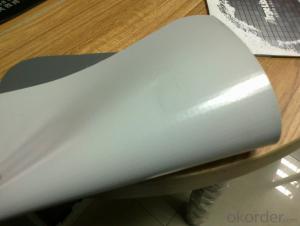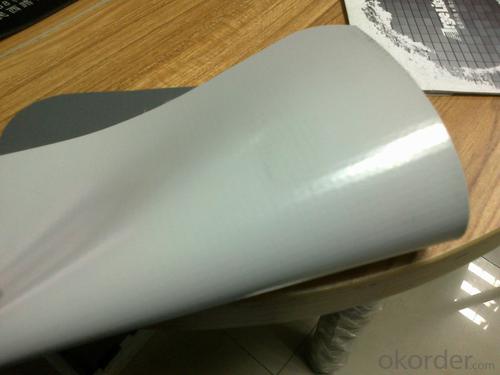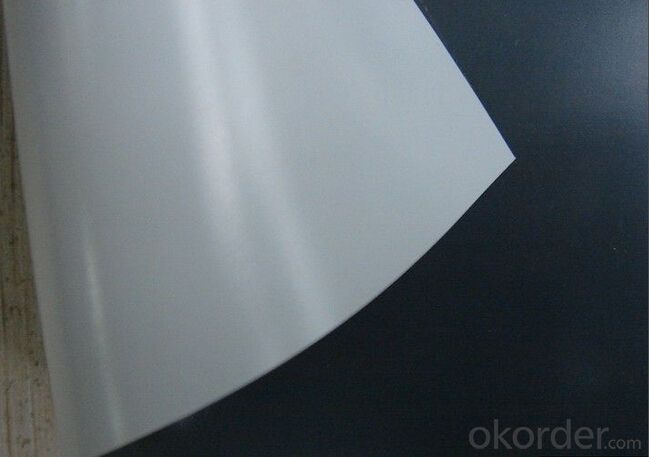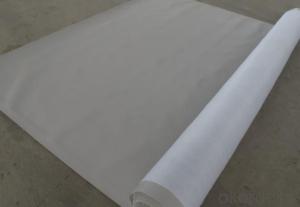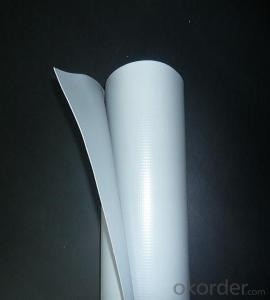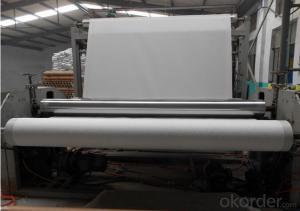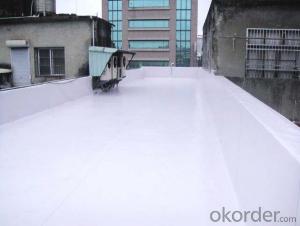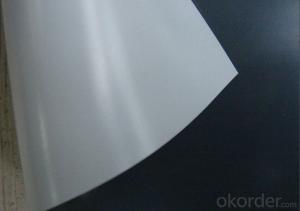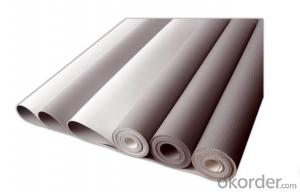Polyvinyl Chloride (PVC) Roofing Waterproofing Membrane
- Loading Port:
- China main port
- Payment Terms:
- TT OR LC
- Min Order Qty:
- 5000 m²
- Supply Capability:
- 100000 m²/month
OKorder Service Pledge
OKorder Financial Service
You Might Also Like
Introduction
Polyvinyl Chloride (PVC) waterproof membrane is a new polymer waterproof membrane which is made from polyvinyl chloride resin, and mixed with plasticizer, filler, antioxygen, ultraviolet absorber and other auxiliaries.
Specification
Length | 20m/roll or customized |
Width | 2.05m |
Thickness | 1.2mm; 1.5mm; 2.0mm |
Type | Homogeneous, Reinforced, Fabric back |
If Exposed | Exposed and Non-exposed |
Color | White, Grey or customized |
Features and Benefits:
a) High Strength
b) Hot-air welded seams for long-term performance
c) Proven membrane performance
d) Excellent resistance to plasticizer extraction and migration performance.
Usage:
a) Roofing (covered & exposed roofs)/ Re- roofing
b) Tunnel Lining
c) Tanking of Underground structures
d) Lining of evaporation ponds & artificial lakes
e) Lining of drinking water tanks & swimming pools
f) Agricultural purposes & Lining of irrigation canals
RFQ
1. What is your MOQ?
--Our MOQ is 5000 m2
2. Can you provide sample?
--Yes, samples are in stock. we can offer free sample for you.
3. Do you offer OEM service?
--Yes, we can print customers’ logo on the packaging;
And the size and specification can be produced and design according to your demand.
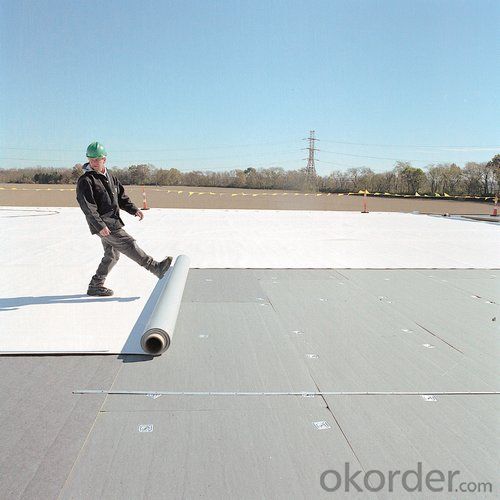
- Q: Can a waterproofing membrane be used in conjunction with fire protection systems?
- Yes, a waterproofing membrane can be used in conjunction with fire protection systems. While the primary function of a waterproofing membrane is to prevent water penetration, it can also act as a barrier to protect against fire. Some waterproofing membranes have fire-resistant properties, allowing them to withstand high temperatures and prevent the spread of fire. However, it is essential to ensure that the specific waterproofing membrane chosen is compatible and approved for use with the fire protection system in question.
- Q: Can a waterproofing membrane be used on roofs with skylights?
- Certainly, roofs with skylights can benefit from the use of a waterproofing membrane. It is strongly advised to employ a waterproofing membrane around skylights in order to prevent water infiltration or leakage. Skylights have the potential to become weak points in a roof system, as they form openings that can let water seep through if not adequately sealed. The application of a waterproofing membrane around the skylights serves to establish a watertight barrier that safeguards the roof from any potential leaks. Furthermore, a waterproofing membrane also offers added protection against external factors such as UV rays and changes in temperature, thereby extending the lifespan of both the skylights and the roof itself.
- Q: Can a waterproofing membrane be used for hospitals or healthcare facilities?
- Hospitals and healthcare facilities can utilize a waterproofing membrane. These membranes are commonly employed in different construction contexts, including hospitals and healthcare facilities, to safeguard against water infiltration and moisture harm. The purpose of these membranes is to establish a barrier that prevents water and moisture from permeating the building envelope, thus ensuring a dry and secure environment. Waterproofing membranes offer several advantages in hospitals and healthcare facilities, where hygiene and cleanliness are paramount. Firstly, they aid in the prevention of mold, mildew, and bacteria growth, which can thrive in damp areas. This is crucial in healthcare settings where patient health and safety are of utmost importance. Moreover, the use of waterproofing membranes safeguards the structural integrity of the building by preventing water damage, such as leaks, that can compromise the stability of the structure. They also contribute to the longevity of the building by preventing damage to walls, floors, and other surfaces caused by water infiltration. Additionally, waterproofing membranes can be tailored to meet the specific needs of hospitals or healthcare facilities. They can be applied to various areas, including basements, foundations, roofs, and bathrooms, to ensure comprehensive water protection throughout the facility. Furthermore, these membranes can be integrated with other waterproofing systems, such as drainage systems, to enhance their effectiveness. In conclusion, waterproofing membranes are a valuable solution for hospitals and healthcare facilities as they provide vital protection against water intrusion, moisture damage, and mold growth. By implementing these membranes, healthcare facilities can maintain a safe, clean, and durable environment for patients, staff, and visitors.
- Q: Does a waterproofing membrane require any special considerations for installation in earthquake-prone areas?
- Yes, a waterproofing membrane does require special considerations for installation in earthquake-prone areas. In such areas, it is crucial to ensure that the membrane is not only resistant to water infiltration but also able to withstand the potential movement and shaking caused by earthquakes. The installation process should include additional measures such as proper anchoring, reinforcing, and flexible joint systems to enhance the membrane's ability to withstand seismic activity and prevent water damage in the event of an earthquake.
- Q: Can a waterproofing membrane be used for temporary structures or tents?
- Indeed, temporary structures or tents can benefit from the utilization of a waterproofing membrane. These membranes are specifically crafted to create a safeguarding shield against water, thwarting any potential harm caused by water infiltration. Consequently, they prove to be an excellent selection for temporary structures or tents, ensuring that the interior remains dry in inclement weather or damp environments. Furthermore, the lightweight and pliable nature of waterproofing membranes simplifies their installation and removal, which is particularly advantageous for temporary structures or tents that necessitate relocation or disassembly.
- Q: Can a waterproofing membrane be used for a foundation wall?
- A foundation wall can indeed utilize a waterproofing membrane. It is highly advisable to employ such a membrane to shield the foundation against water infiltration and moisture-related harm. Typically, this membrane is applied on the outer side of the foundation wall, serving as a barrier to prevent water from penetrating. Its design entails flexibility, durability, and resistance to hydrostatic pressure, thereby ensuring long-lasting protection for the foundation. Moreover, the membrane aids in preventing water from seeping into the basement or crawl space, thereby decreasing the risk of mold, mildew, and structural problems. Ultimately, employing a waterproofing membrane for a foundation wall is an effective means of safeguarding the building's foundation, guaranteeing its integrity and longevity.
- Q: Can a waterproofing membrane be used on tunnels with vehicular traffic?
- Yes, a waterproofing membrane can be used on tunnels with vehicular traffic. Waterproofing membranes are designed to provide a barrier against water infiltration, protecting the structure from potential damage caused by moisture. In tunnels with vehicular traffic, water can seep through the concrete and cause corrosion, deterioration, and even compromise the structural integrity of the tunnel. By applying a waterproofing membrane, it creates a protective layer that prevents water from penetrating the tunnel walls, roof, and floor. This helps to extend the lifespan of the tunnel and ensures the safety of vehicles passing through. However, it is essential to select a waterproofing membrane specifically designed for heavy traffic conditions to withstand the constant load and wear. Additionally, proper installation and regular maintenance are crucial to ensure the effectiveness and longevity of the waterproofing system in tunnels with vehicular traffic.
- Q: Basement SBS Waterproof Coil Division I and II type What is the difference? How is the site identified?
- Type I low temperature flexibility is -20 degrees, pulling force of 500N / 5cm, elongation of 30%. Type II low temperature is -25 degrees, tension of 800N / 5cm, elongation of 40%. The appearance of the general can not distinguish, you can take the sample to the laboratory to be a tensile test on it.
- Q: What is the resistance type SBS waterproofing membrane?
- The third is the combination of the above two principles. SBS resistant root puncture membrane has three kinds: 1, composite copper fetal base SBS modified asphalt waterproofing membrane. Mainly using copper tires to puncture strength, while copper ion drive plant roots. 2, copper foil tire SBS modified asphalt waterproofing membrane. Mainly the use of copper ion drive plant roots, while a certain anti-piercing strength. 3, SBS modified asphalt root resistant puncture waterproofing membrane. Mainly chemical resistance to root.
- Q: Can a waterproofing membrane be used in shower pans?
- Yes, a waterproofing membrane can be used in shower pans. In fact, it is highly recommended to use a waterproofing membrane in shower pans to prevent water leakage and damage to the underlying structure.
Send your message to us
Polyvinyl Chloride (PVC) Roofing Waterproofing Membrane
- Loading Port:
- China main port
- Payment Terms:
- TT OR LC
- Min Order Qty:
- 5000 m²
- Supply Capability:
- 100000 m²/month
OKorder Service Pledge
OKorder Financial Service
Similar products
Hot products
Hot Searches
Related keywords
